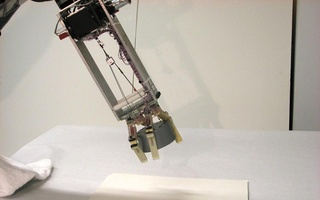Researchers at the Harvard School of Engineering and Applied Sciences have developed a mechanism for tactile sensation that will allow robotic machinery to be more gentle, durable, and affordable than before.
Known as TakkTile, the new technology allows for more reliable and precise touch sensors, and researchers say that potential use of the new mechanism can be fully realized by future innovation.
“There were already [many ways] to develop tactile sensors,” said Yaroslav Tenzer, a post-doctoral fellow at SEAS and co-creator of TakkTile. “Unfortunately, all of them have disadvantages. They are fragile, they are not robust, and they are far too expensive.”
Because of this, Tenzer and fellow designer Leif P. Jentoft, a Ph.D student at SEAS, built a new sensor called TakkTile that is sensitive to the level of one gram, able to withstand up to 25 pounds of pressure or a hit from a baseball bat, and extremely cheap to assemble.
The combination of durability and cost is what makes TakkTile unique. Previously, technology that could provide such a high level of sensitivity could typically only be found in a research laboratory. Most systems would be too weak for everyday use and too expensive for practical applications.
“There’s nothing else that is cheap and easy to manufacture that can be this sensitive,” Jentoft said. Tenzer added that TakkTile technology is “ten times cheaper” than anything else on the market.
Encased in a protective layer of rubber, TakkTile uses a miniature barometer to detect slight changes in pressure and react to very slight touches. These barometers are commonly found in GPS locators and cellphones, and are thus available cheaply.
Depending on the project, developers could potentially use hundreds of TakkTiles at a very low cost. “If you want to cover a small area, you would only need one of them,” Jentoft said. “But if you have a different application, then you could use hundreds of them to tailor the use directly to your need.”
According to Jentoft and Tenzer, the applications of TakkTile are far-reaching. While researchers developed them to provide a sort of nervous system for robotic hands in an effort to make their robots more dexterous and gentle, the co-creators stressed that the true value of the project lies in the applications that other designers will find for it.
“Any researcher who needs a sensitive robotic object can basically build it now,” Tenzer said. “The basic functionality is so awesome and could have so many uses.”
Read more in News
Memory May Influence Motivation, Research Suggests














